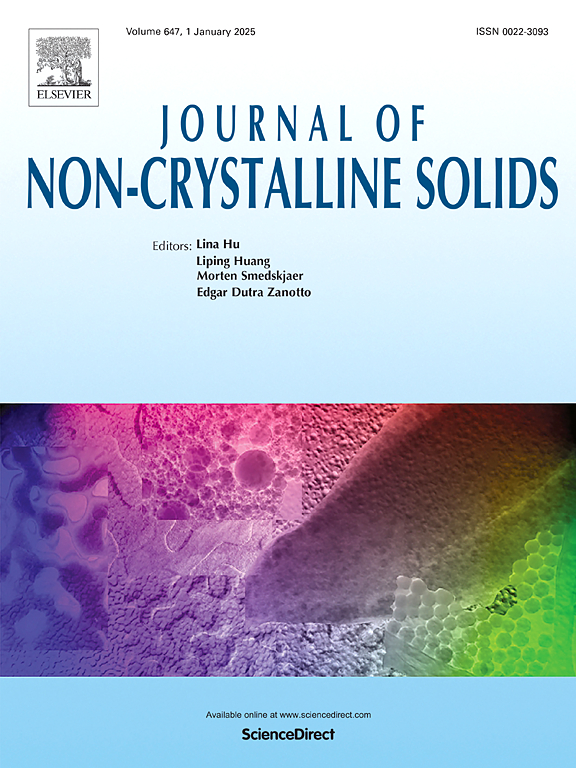Investigation of critical phenomena and magnetocaloric effect (MCE) in amorphous Tb₈₀Au₂₀ foils
IF 3.5
3区 材料科学
Q1 MATERIALS SCIENCE, CERAMICS
引用次数: 0
Abstract
This work investigates the magnetic critical behavior and magnetocaloric effect (MCE) of an amorphous Tb₈₀Au₂₀ alloy. Rare-earth–based amorphous systems are of interest both for their unusual magnetic properties and their potential in energy-efficient cooling technologies. Magnetization measurements reveal a second-order transition from the ferromagnetic to the paramagnetic state at a Curie temperature of about 70 K. To characterize this transition, we determined the critical exponents (β, γ, δ, and n) using several complementary techniques: Modified Arrott plots (MAP), Kouvel–Fisher analysis (K-F), critical isotherm method (CIA), and Widom scaling relation (WSR): β = 0.395, γ = 1.064, δ = 3.03, and n ≈ 0.78. The values obtained are consistent across these approaches and closely follow the predictions of the mean-field model, indicating that long-range ferromagnetic interactions dominate in this amorphous compound. The magnetocaloric properties were also examined to validate the critical behavior. The alloy exhibits a maximum magnetic entropy change of approximately 2.30 J kg⁻¹ K⁻¹ and a relative cooling power of about 322 J kg⁻¹ under an applied field change of 0–4.5 T The broad temperature span of the entropy change, combined with the absence of thermal and magnetic hysteresis, confirms the advantages of second-order transitions. These findings highlight the potential of Tb-based amorphous alloys as promising candidates for cryogenic magnetic refrigeration.
无定形Tb₈₀Au₂₀箔的临界现象及磁热效应研究
本文研究了一种无定形Tb₈₀Au₂₀合金的磁临界行为和磁热效应。稀土基非晶体系因其独特的磁性和在节能冷却技术方面的潜力而引起人们的兴趣。磁化测量表明,在居里温度约为70k时,从铁磁态到顺磁态发生了二阶跃迁。为了描述这一转变,我们使用几种互补技术确定了临界指数(β, γ, δ和n):修正Arrott图(MAP), Kouvel-Fisher分析(K-F),临界等温线法(CIA)和Widom缩放关系(WSR): β = 0.395, γ = 1.064, δ = 3.03, n≈0.78。这些方法得到的值是一致的,并且与平均场模型的预测密切相关,表明在这种非晶化合物中,远程铁磁相互作用占主导地位。还对其磁热特性进行了测试,以验证其临界行为。在0-4.5 T的磁场变化下,该合金的最大磁熵变化约为2.30 J kg⁻¹,相对冷却力约为322 J kg⁻¹。熵变化的宽温度范围,加上没有热滞后和磁滞后,证实了二阶转变的优势。这些发现突出了碲基非晶合金作为低温磁制冷材料的潜力。
本文章由计算机程序翻译,如有差异,请以英文原文为准。
求助全文
约1分钟内获得全文
求助全文
来源期刊

Journal of Non-crystalline Solids
工程技术-材料科学:硅酸盐
CiteScore
6.50
自引率
11.40%
发文量
576
审稿时长
35 days
期刊介绍:
The Journal of Non-Crystalline Solids publishes review articles, research papers, and Letters to the Editor on amorphous and glassy materials, including inorganic, organic, polymeric, hybrid and metallic systems. Papers on partially glassy materials, such as glass-ceramics and glass-matrix composites, and papers involving the liquid state are also included in so far as the properties of the liquid are relevant for the formation of the solid.
In all cases the papers must demonstrate both novelty and importance to the field, by way of significant advances in understanding or application of non-crystalline solids; in the case of Letters, a compelling case must also be made for expedited handling.
 求助内容:
求助内容: 应助结果提醒方式:
应助结果提醒方式:


